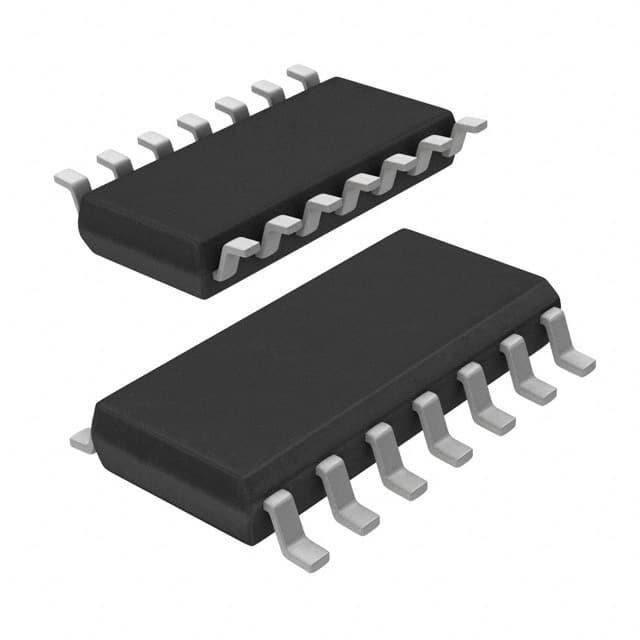Подробную информацию о продукте см. в характеристиках.

74HC58D,653
Basic Information Overview
- Category: Integrated Circuit (IC)
- Use: Digital Logic IC
- Characteristics: High-speed operation, low power consumption, compatibility with TTL levels
- Package: SOIC (Small Outline Integrated Circuit)
- Essence: 8-bit priority encoder
- Packaging/Quantity: Tape and Reel, 2500 units per reel
Specifications
- Supply Voltage Range: 2.0V to 6.0V
- Input Voltage Range: -0.5V to VCC + 0.5V
- Operating Temperature Range: -40°C to +125°C
- Output Current: ±25mA
- Propagation Delay: 15ns (typical)
Detailed Pin Configuration
- A0 (Input)
- A1 (Input)
- A2 (Input)
- A3 (Input)
- A4 (Input)
- A5 (Input)
- GND (Ground)
- Y (Output)
- E (Enable)
- VCC (Supply Voltage)
Functional Features
The 74HC58D,653 is an 8-bit priority encoder that encodes the highest priority input into a binary code. It features a high-speed operation, making it suitable for applications requiring quick encoding. The low power consumption of this IC ensures efficient energy usage. Additionally, it is compatible with TTL logic levels, allowing seamless integration with other digital logic circuits.
Advantages and Disadvantages
Advantages: - High-speed operation enables rapid encoding. - Low power consumption results in energy-efficient performance. - Compatibility with TTL levels allows easy integration with existing systems.
Disadvantages: - Limited to 8-bit encoding, may not be suitable for applications requiring higher bit counts. - Requires external enable signal for proper functioning.
Working Principles
The 74HC58D,653 operates based on the priority encoding principle. It accepts multiple input lines (A0-A5) and encodes the highest priority active input into a binary code. The enable pin (E) controls the operation of the IC. When enabled, the encoder scans the input lines and determines the highest priority active input. The corresponding binary code is then presented at the output pin (Y).
Detailed Application Field Plans
The 74HC58D,653 finds applications in various fields where priority encoding is required. Some potential application areas include: - Data communication systems - Industrial automation - Robotics - Security systems - Traffic control systems
Detailed and Complete Alternative Models
- 74HC148: 8-line to 3-line priority encoder
- 74LS148: 8-line to 3-line priority encoder
- CD74HC148: High-speed CMOS logic 8-line to 3-line priority encoder
- CD74LS148: Low-power Schottky TTL 8-line to 3-line priority encoder
These alternative models offer similar functionality to the 74HC58D,653 and can be used as substitutes depending on specific requirements.
In conclusion, the 74HC58D,653 is an 8-bit priority encoder IC with high-speed operation, low power consumption, and compatibility with TTL levels. It finds applications in various fields such as data communication, industrial automation, robotics, security systems, and traffic control. Alternative models like 74HC148, 74LS148, CD74HC148, and CD74LS148 provide similar functionality and can be considered as alternatives.
Перечислите 10 распространенных вопросов и ответов, связанных с применением 74HC58D,653 в технических решениях.
Sure! Here are 10 common questions and answers related to the application of 74HC58D,653:
Q: What is the 74HC58D,653? A: The 74HC58D,653 is a high-speed CMOS 8-bit parallel-in/serial-out shift register with asynchronous reset.
Q: What is the purpose of a shift register? A: A shift register is used to convert parallel data into serial data or vice versa. It can be used for various applications such as data storage, data transfer, and control signal generation.
Q: What is the maximum clock frequency supported by the 74HC58D,653? A: The 74HC58D,653 can operate at a maximum clock frequency of 25 MHz.
Q: How many parallel inputs does the 74HC58D,653 have? A: The 74HC58D,653 has 8 parallel inputs (A0-A7).
Q: Can the 74HC58D,653 be cascaded to increase the number of bits? A: Yes, multiple 74HC58D,653 shift registers can be cascaded together to increase the number of bits.
Q: What is the output format of the 74HC58D,653? A: The 74HC58D,653 has a serial output (Q7) that can be connected to the input of another shift register or any other device that accepts serial data.
Q: Does the 74HC58D,653 support both synchronous and asynchronous reset? A: Yes, the 74HC58D,653 supports both synchronous and asynchronous reset. The asynchronous reset (MR) pin can be used to clear the shift register to a known state.
Q: What is the power supply voltage range for the 74HC58D,653? A: The 74HC58D,653 operates with a power supply voltage range of 2V to 6V.
Q: Can the 74HC58D,653 be used in both digital and analog applications? A: No, the 74HC58D,653 is specifically designed for digital applications and should not be used in analog circuits.
Q: Are there any specific precautions to consider when using the 74HC58D,653? A: It is important to ensure that the power supply voltage does not exceed the specified range, and proper decoupling capacitors should be used near the power supply pins. Additionally, care should be taken to avoid static discharge during handling and installation of the chip.
Please note that these answers are general and may vary depending on the specific application and requirements.

